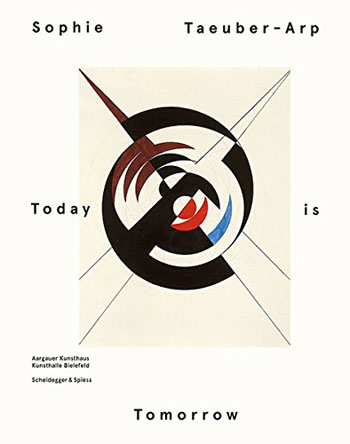|
SOPHIE TAEUBER-ARP : TODAY IS TOMORROW
Edited by Thomas Schmutz
Scheidegger and Spiess (distributed by the
Reviewed by Jim Burns
It could be that the name of Sophie Taeuber-Arp will, for most
people, immediately bring to mind the antics of the Dadaists at the
Cabaret Voltaire in
There was far more to Sophie Taeuber-Arp than the contributions she
made to the Dadaist revolt. Born in
The largely male-dominated avant-garde was not a place to look for
enlightened views about the role of women generally. And the Dada
movement was noted for its liking for manifestos, which Taeurber-Arp
thought were essentially “a means of self-aggrandisement”. She said:
“If I were an artist and my name were constantly made to look
foolish by such shouting, squealing, howling, scrawling, and
printing, then I would stuff mud in the author’s mouth and bite his
finger so that he couldn’t do it anymore. All that matters is the
work. Making manifestos like that is more than idiotic”. She didn’t
need to add that manifestos were often mainly a male prerogative.
The evidence offered in Today
is Tomorrow seems to refute the suggestion that Sophie
Taeuber-Arp was, in any way, lacking when it came to being seen as
avant-garde and a pioneer in the high arts. Richter said that “she
was above all a painter of modern abstracts at a time when abstract
painting was still in its infancy”.
Her contribution to the activities of the Dadaists appears to
have been quite significant. With regard to the masks she designed,
Hugo Ball said that they “dictated utterly specific, lofty, even
nearly mad gestures”. She herself took part as a dancer in some of
the Dada performances.
The Dada movement eventually and inevitably petered out, with
individuals moving into different areas of activity in the 1920s.
Taeuber-Arp had continued to earn a living by being steadily
employed in aspects of the applied arts. But after 1926 she gave up
“making small-format wood objects and beadwork………She continued to
design textile wall hangings, but at the same time, became more
occupied with large-format murals and colourful window designs”.
It was around this time that the Arps decided to move to
Despite the suggestion of a reluctance to promote herself, there is
plenty of evidence to show that Taeuber-Arp was “internationally
well-known, that she corresponded in several languages without any
difficulty, held the reigns and ignited the spark for quite a few
projects, whether her own or those of others, and accompanied them
persistently. She was a networker and a doer, not primarily a
dreamer – or at least one who was quite capable of differentiating
between dream and reality”.
She became active in avant-garde groups in
A reproduction of the front cover of the fifth issue lists Hans Arp,
Leonora Carrington, Marcel Duchamp, Paul Eluard, and Max Ernst as
among the contributors. Earlier issues had illustrations by
Malevich, El Lissititzky, and others. As it happened, the fifth
issue, published in 1939, was the last one. Taeuber-Arp had wanted
it to continue, but with the situation in
It’s obvious from this profusely illustrated book that Taeuber-Arp
was a multi-talented artist. While allowing for the fact of the
prejudice that existed, and perhaps still does, against applied art
when compared to so-called fine art, it may have been that not
enough serious consideration was given to her work because she
functioned in so many different fields. It seems to be true, too,
that Hans Arp was less than positive in his later appreciations of
the work she did: “Hans Arp, in poems and everyday statements,
presents Taeuber-Arp to posterity as a dreamer and an artist who
primarily works intuitively”. With regard to her activities in the
applied arts, he additionally appeared to be concerned “that the
inclusion of these practical activities would led to a devaluation
of Sophie Taeuber’s artistic achievement, placing it on a par with
arts and crafts”.
It’s also worth noting that:
“The authors of the first and to-date only catalogue raisonné
on Sophie Taeuber’s oeuvre, although well-intentioned and based on
decisions based on decisions made in a particular era, already
deliberately ignored works and work genres, or did not recognise
them as part of a body of work”.
Sophie Taeuber-Arp Today is Tomorrow
is a splendidly informative book in that it illustrates the full
range of her activities. The arguments about the supposed
differences between applied and fine arts will no doubt continue.
And some people will always look at a lot of geometric abstraction
paintings and see them as having more to do with design and
decoration than with “pure” art. Their opinions might be reinforced
by a casual comparison of certain of her paintings and some of her
textile designs. It could also be true that the old cliché about
someone being a “Jack of all trades, but master of none” might be
called into play when Taeuber-Arp’s work is discussed. She involved
herself “in the areas of design, painting, textiles, drawing,
sculpture, clothing, architecture, theatre, and dance”.
Can anyone be so equally talented in such a wide range of
activities? She may well have excelled more in one or other
of her involvements, but the evidence provided by the book seems
to show that she maintained a high standard in all of them.
This is a second, revised edition of a publication originally
designed to accompany the exhibition,
Sophie Taeuber-Arp: Today is
Tomorrow at the Aargauer Kunsthaus Aarau 23rd August, 2014, to
16th November, 2014, and Kunsthaus Bielefeld 12th December, 2014
to 15th March, 2015.
|
